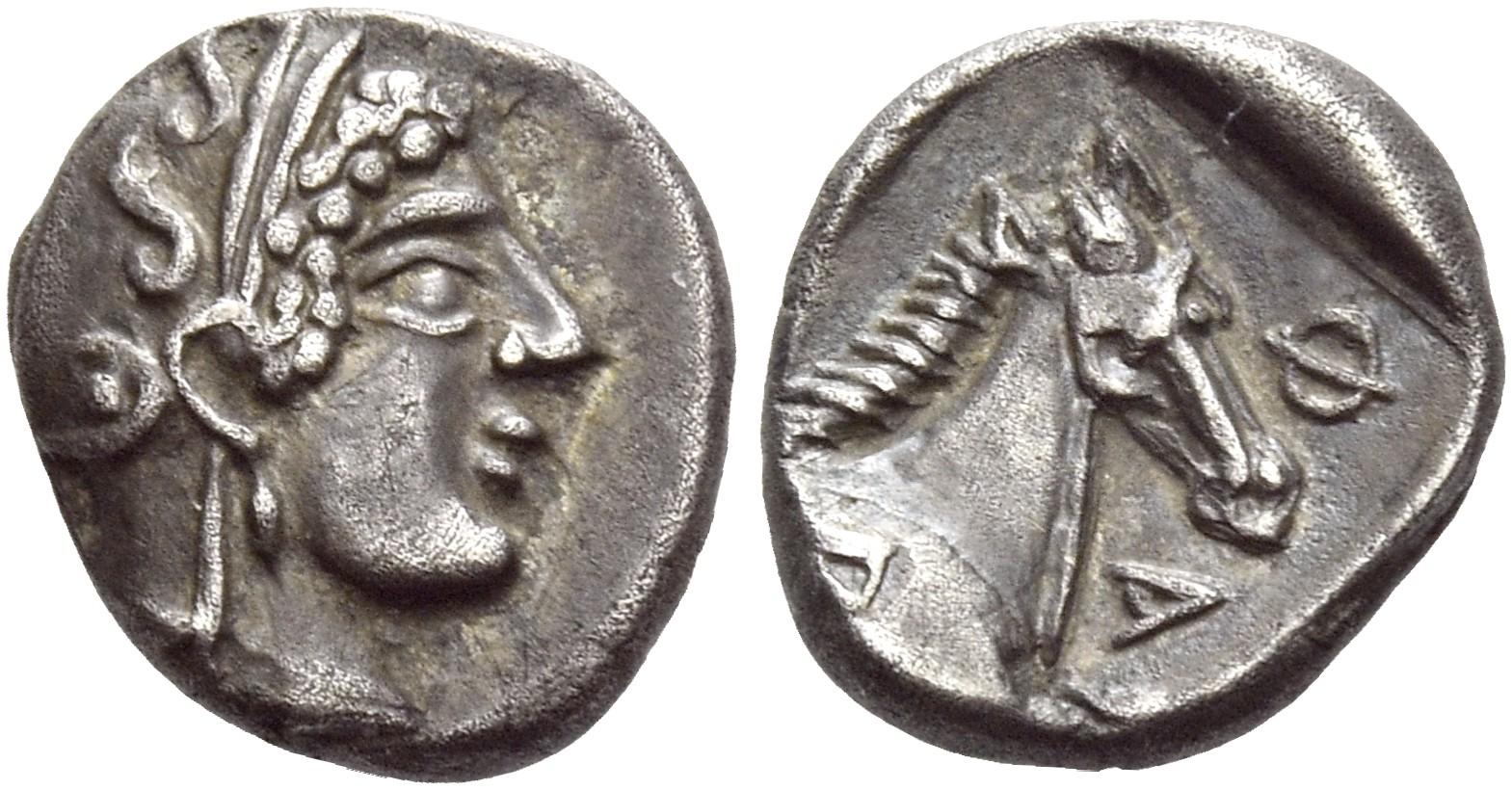AC 181 - Pharsalus, silver, obols (479-425 BCE)
From SILVER
479 BCE - 425 BCE Silver 256 kg
Description
| ObverseInscription or printing placed on the obverse.: | Head of Athena r., wearing earring and Attic helmet decorated with a snake |
| ReverseInscription or printing placed on the reverse.: | ΦAP (Greek).Head of horse r. |
Mint and issuing power
| MintIdentifies the place of manufacture or issue of a numismatic object.: | Pharsalus | Ancient regionAncient region.: | Thessaly | Modern countryModern country: Greece | AuthorityIdentifies the issuing power. The authority can be "pretended" when the name or the portrait of X is on the coin but he/she was not the issuing power. It can also be "uncertain" when there is no mention of X on the coin but he/she was the issuing power according to the historical sources: |
Chronology
| FromIdentifies the initial date in a range assigned in a numismatic context. | 479 BCE | toIdentifies the final date in a range assigned in a numismatic context.. | 425 BCE | PeriodTime period of the numismatic object.: Classical 480-323 BC |
Physical description
| MetalThe physical material (usually metal) from which an object is made.: | Silver |
Median weightMedian of the weights of numismatic objects (in grams). in grams | 0.90 | DenominationTerm indicating the value of a numismatic object. Examples: tetradrachm, chalkous, denarius.: | obol |
StandardStandard.: |
Image

AC181 Pharsalus obol.jpg [1]
References
| Die study referencePublication of the study: | Lavva 20011Lavva 2001, n° 4, 7, 10, 14, 20, 22-3, 37, 42, 45 | ||
| Coin series referenceReference to coin series study: | Sear I2Sear I, n° 2188, RQEMAC3RQEMAC, n° 181 | ||
Obverse dies distribution
| FrequencyFrequency of specimen in distribution. ᵖ | Number of obversesNumber of obverse dies. ᵖ (o) | % (o) | Number of coinsNumber of coins. (n) | % (n) | Die nameName(s) of the die(s). |
| 1 | 4 | 36.36 | 4 | 12.5 | 23, 25, 26, 28 |
| 2 | 2 | 18.18 | 4 | 12.5 | 13, 15 |
| 3 | 1 | 9.09 | 3 | 9.38 | 5 |
| 4 | 2 | 18.18 | 8 | 25 | 10, 22 |
| 6 | 1 | 9.09 | 6 | 18.75 | 7 |
| 7 | 1 | 9.09 | 7 | 21.88 | 3 |
| Total | 11 of 11 | 99.99 | 32 of 32 | 100.01 |
Reverse dies distribution
no distribution is available
Quantification
| Number of obversesNumber of obverse dies. ᵖ (o) | 11 | Number of singletons (o1)The number of singleton coins. ᵖ | 4 |
| Number of reverse diesNumber of reverse dies. (r) | Number of coinsNumber of coins. (n) | 32 | |
| Coins per obverse dieNumber of coins per obverse die. (n/o) | 2.91 | Coins per reverse dieNumber of coins per reverse die. (n/r) | |
| Reverse per obverse ratioRatio of obverse dies divided by reverse dies. (r/o) | Percentage of singletons (o1)number of coins (n) divided by the number of singletons (o1) ᵖ | 36.36 % | |
| Original number of dies (O) (Carter 1983 formula)The estimation of the number of coins according to Carter 1983 ᵖ | 14.2 | Coins struck if 20,000 as average productivity per dieCoins made if the average productivity for obverses (according to Carter) is 20,000. ᵖ | 284,000 |
| Original number of dies (O) (Esty 2011 formula)The estimation of the number of coins according to the singleton formula in Esty 2011 ᵖ (O) | 16.76 | Survival rate if 20,000 as average productivity per dieSurvival rate if average productivity is 20,000. ᵖ | 0.00011 |
| Coverage (o = % of O) (Esty 1984 formula)Esty 1984 - coverage (% of O) ᵖ (o = % of O) | 87.5% | Die productivity if survival rate 1/2,000Average productivity if survival rate is 1/2,000. ᵖ | 4,507.04 |
| Weight of silver (in kg) if 20,000 coins per die (O = Carter formula)Carter 1983 * Median weight * 20000 (*10 if gold or electrum) ᵖ | 256 kg <br /> 256 kg | Die productivity if survival rate 1/5,000Average productivity if survival rate is 1/5,000. ᵖ | 11,267.61 |
Remarks
Most likely one single workstation
References
- ^ Lavva, Stella (2001), Die Münzprägung von Pharsalos, Saarbrücken, 254 p., 29 pl.
- ^ Sear, David R. (1978), Greek coins and their values. Vol. I, Europe, London, xl, 316 p.
- ^ Callataÿ, François de (2003), Recueil quantitatif des émissions monétaires archaïques et classiques, Numismatique Romaine, Wetteren, VII + 267 p.